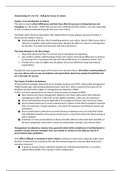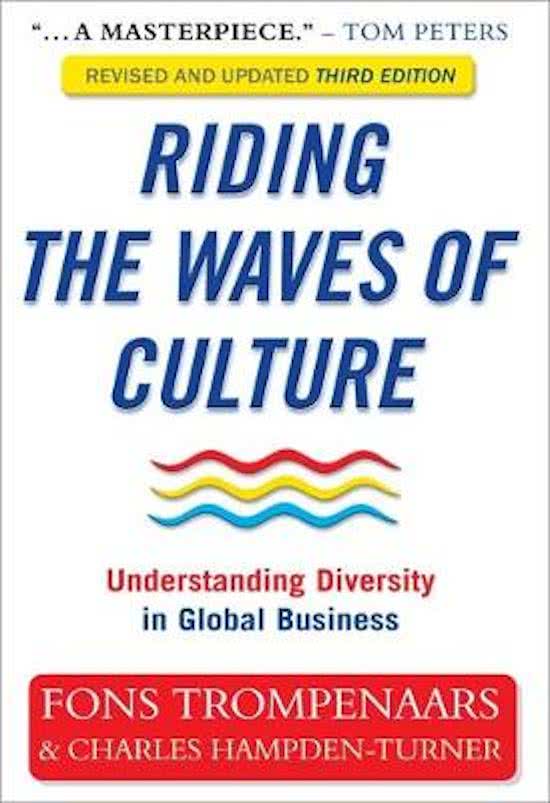Samenvatting H1 t/m H11 – Riding the waves of culture
Chapter 1) An introduction to Culture
This book is about cultural differences and how they affect the process of doing business and
managing. It is the writer's’ belief that you can never understand other cultures. It is even impossible
to ever completely understand people from your own culture.
The Dutch author became interested in this subject before it grew popular, because his father is
Dutch and his mother is French.
● Understanding of the fact that if something works in one culture, there is little chance that It
will work in another. Both authors have been studying the effect of culture on management
for decades. This book describes what they have discovered.
This book attempts to do three things;
1. Dispel the notion that there is one best way of managing and organizing;
2. Give readers a better understanding of their own culture and cultural differences in general
by learning how to recognize and cope with these differences in a business context, and;
3. Provide some cultural insights into the global versus local dilemma facing international
organizations.
Possibly the most important aspect of the book is the second of these. We believe understanding of
our own culture and our own assumptions and expectations about how people should think and
act is the basis for success.
The impact of Culture on Business
All international managers know that in the strategic business unit (SBU), total quality management
(TQM) should reign, with products delivered just in time (JIT), where customer first teams (CFTs)
distribute products while subject to management-by-objectives (MBO).
If this is not done appropriately, we need to business process reengineer (BPR).
● How universal are these management solutions? Are these truths about what effective
management really is: truths that can be applied anywhere, under any circumstances?
● These well-intended universal applications of management theory have turned out badly.
● Pay-for-performance has in many instances been a failure on the African continent, because
there are particular, though unspoken, rules about the sequence and timing of reward and
promotions.
● Pay-for-performance will not be successful because employees may not accept the notion
that individual members of the group should excel in a way that reveals the shortcomings of
other members.
● Customers in more communitarian cultures also take offense at the quick buck mentality of
the best salespeople; they prefer to build up relationships carefully, and maintain them.
Management-by-objectives schemes have generally failed within subsidiaries of multinationals in
southern Europe, because managers have not wanted to conform to the abstract nature of
preconceived policy guidelines.
Even HRM is difficult to translate to other cultures, coming as it does from a typically Anglo-Saxon
doctrine. It borrows from economics the idea that human beings are resources like physical and
monetary resources.
● It tends to assume almost unlimited capacities for individual development. In countries
without these beliefs, this concept is hard to understand.
,International managers have it tough. They must operate on several different premises at any one
time. These premises arise from their culture of origin, the culture in which they are working, and the
culture of the organization that employs them.
In every culture: such phenomena as authority, bureaucracy, creativity, good fellowship, verification
and accountability are experienced in different ways.
● That we use the same words that our cultural biases and our accustomed conduct may not
be appropriate or shared.
● There is a presumption that internationalization will create or lead to a common culture
worldwide. This commonality would make the life of international managers much simpler.
● It is about what things mean to people in each culture. The essence of culture is not what is
visible on the surface. It is the shared ways groups of people understand and interpret the
world.
o Dining at McDonald’s was at one time a show of status in Moscow, whereas it is fast
meal for a fast buck in New York.
If business people want to gain understanding of and allegiance to their corporate goals, policies,
products or services, wherever they are doing business, they must understand what those and other
aspects of management mean in different cultures.
● In addition to exploring why universal applications of Western management theory may not
work > trying to deal with the growing dilemma facing international managers that is known
as glocalization. As markets globalize, the need for standardization in organizational
design, systems and procedures increases.
● Yet managers are also under pressure to adapt their organizations to the local characteristics
of the market, the legislation, the fiscal regime, the sociopolitical system and the culture
system. This balance between consistency and adaption is essential for corporate success.
Paralysis Through Analysis: The Elixir of the Management Profession
Peters and Waterman in: In Search of Excellence
● Western analytical thinking has led to many international successes in fields of technology.
Indeed, technologies do work by the universal rules everywhere, even on the moon.
● The human being is a special piece of technology, and the results of our studies, extensively
discussed in this book, indicate that the social world of the international organization has
many more dimensions to deal with.
● Some managers recognize the multidimensional character of their companies. They seem
able to use a logic appropriate to machines (analytic-rational) and a logic more appropriate
to social relations (synthetic-intuitive), switching between the two as needed.
In the process of internationalization of the Japanese increasingly take the functioning of local society
seriously.
● They were not the first to observe ‘When in Rome..’, but they seem to act on this precept
more than Westerners do. The Japanese have added another dimension: When in Rome,
understand the behavior of the Romans, and thus become an even more complete
Japanese.
In opposition we have our Western approach, based on American business education, which treats
management as a profession and regards emotionally detached rationality as scientifically necessary.
Statistical analysis, forecasting techniques and operational studies are not wrong. These endeavors
comprise important technical skills. The mistake is to assume that technical rationally should
characterize the human element in the organization.
, No one is denying the existence of universally applicable scientific laws with objective consequences.
These laws are culture free.
● However, the belief that human cultures in the workplace should resemble the laws of
physics and engineering is a cultural, not a scientific belief.
● It is a universal assumption that does not win universal agreement, or even come close to
doing so. The internationalization of business life requires more knowledge of cultural
patterns.
How proven formulas can lead to wrong results
Why is it that many management processes lose effectiveness when cultural borders are crossed?
● Formulas are used overseas > these are made based on their own culture.
o This is why those formulas may not work abroad. The cultural differences are
neglected.
In Italy bosses are like fathers and you cannot have two fathers.
Culture is like gravity; you do not experience it until you jump six feet into the air.
● Local managers may not openly criticize a centrally developed appraisal system or reject the
matrix organization, especially if confrontation or defiance is not culturally acceptable to
them. In practice, the silent forces of culture operate a destructive process, biting at the
roots of centrally developed methods that do not fit locally.
The flat hierarchy, SBU’s, MBO, matrix organizations, assessment centers, TQM, BP and pay-for-
performance are subjects of discussion in nearly every bestseller about management.
Although the organizational theory developed in the 1970s introduced the environment as an
important consideration, it was unable to kill the dream of the one best way of organizing. It did not
measure the effects of national culture, but systematically pointed to the importance of the market,
the technology, and the product for determining the most effective methods of management and
organization.
Leading company practices have been carefully imitated, or even technologies have their own
imperatives. Research of this kind has often claimed that this proves that the organization is culture
free. The issue is not whether a hierarchy in the Netherlands has six levels, as does a similar company
in Singapore, but what the hierarchy at those levels mean to the Dutch and Singaporeans. There the
meaning is totally different.
Culture is the way in which people solve problems
Culture is the way in which a group of people solves problems and reconciles dilemmas.
● Culture comes in layers, like an onion. To understand it, you have to unpeel it layer by layer.
● On the outer layer are the products of culture, such as the soaring skyscrapers of Manhattan,
pillars of private power, with congested public streets between them. These products are
expressions of deeper values and norms in a society that are not directly visible.
● The layer of values and norms are deeper within the ‘onion’ and more difficult to identify.
A problem that is regularly solved disappears from consciousness and becomes a basic assumption,
an underlying premise. These basic assumptions define the meaning that a group shares. They are
implicit.
● What is taken for granted, unquestioned reality: this is the core of the onion.
National, corporate and professional culture
Culture also presents itself on different levels.






